Are you looking for a loyal, loving, and family-friendly companion? Look no further than the King Shepherd! This majestic breed is a recent mix of the German Shepherd, the Shiloh Shepherd, and the Alaskan Malamute, resulting in a dog that is every bit as good as a German Shepherd but with far fewer health issues.
With their pointed ears, long snout, and thick fur on their strong, sturdy bodies, King Shepherds are truly the embodiment of “man’s best friend.”
In this blog, we’ll explore the fascinating history, unique characteristics, and proper care of this incredible breed. Get ready to fall in love with the King Shepherd!
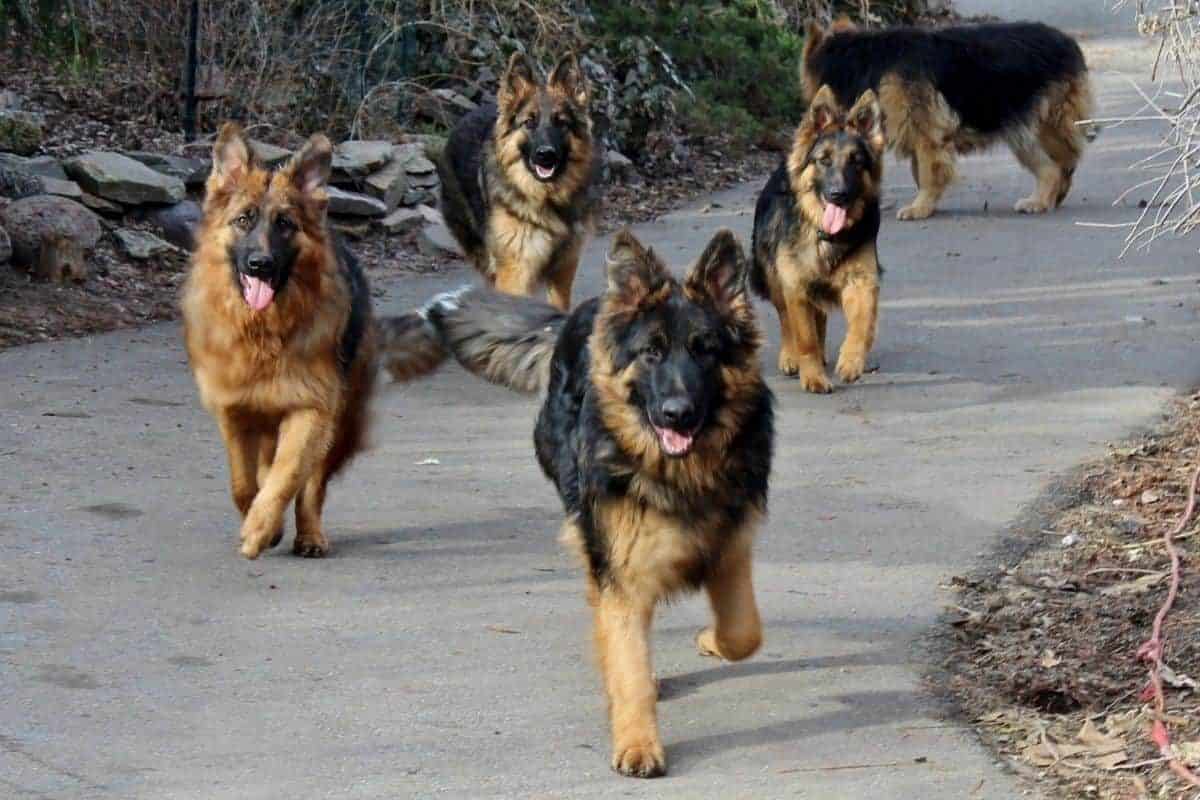
If you want to learn all about the King Shepherd breed, you won’t be disappointed. But first, here’s a tabled glance at the breed.
| King Shepherd | Breed Characteristics |
|---|---|
| Group | Herding |
| Origin | America |
| Other Names | American King Shepherd |
| Breed Size | Large |
| Height | 27-31 inches (Males) 25-27 inches (Females) |
| Weight | 130-150 pounds (Males) 90-110 pounds (Females) |
| Temperament | Affectionate, Courageous, Protective, Watch-dog, Strong, Confident, Gentle, Intelligent, Independent, Loyal, Energetic, Sensitive, Aloof with Strangers, Adaptable |
| Appearance | Balanced Hip Angulation, Straight Back, Strong Muscle, Heavy Bone, Large Head, Well Proportioned |
| Lifespan | 10-11 years |
| Health Issues | Hypothyroidism, Joint Dysplasia, Von Willebrand’s Disease, Bloat (GDV) |
| Coat Colors | Black and Tan, Black, Bicolor, Black and Red, Sable |
| Coat Type | Double-coat, Medium or Long |
| Shedding | Heavy |
| Grooming | Moderate |
| Easy to Train | Yes |
| Exercise Needs | Medium-High |
| Hypoallergenic | No |
| Child Friendly | Yes |
| Pet Friendly | Yes |
| Good for new owners | No |
| Cost | $1500 – $3000 |
What is a King Shepherd?
A King Shepherd is a “King Sized” German Shepherd hybrid bred by mating a German Shepherd with a larger dog like the Alaskan Malamute, Great Pyrenees, or Akita. Consequently, a King Shepherd is larger than a GSD yet retains a similar appearance but a calmer temperament.
Pioneered by Shelley Watts-Cross and David Turkheimer, this “breed” is technically a collection of breeds sharing similar physical and personality characteristics. This was back in 1990, and since there were no kings who liked to herd sheep, the title of “King Shepherd” was vacant.
Due to the dog’s size, this title became socially adopted by 1995 when the first society was built around the “breed.” You can find the breed standard here.
Given that the crosses that result in King Shepherds are broad, the breed is considered in its infancy. Only after “purebred” King Shepherds produce predictable King Shepherd offspring the breed will become “mainstream.”
Becoming mainstream will lead to broad availability, lower prices, and better recognition.
Are King Shepherds Rare?
Broader recognition and broader availability aren’t correlated. Some dogs can get better recognized yet remain rare because of breeding costs. With the King Shepherd’s popularity on the rise, you might wonder if the dog is actually becoming more easily available.
King Shepherds are deemed rare and are recognized by the American Rare Breed Association. Breeding King Shepherds involves cross-mating specific breeds, which isn’t a very lucrative niche for most breeders, who would rather breed a purebred GSD with a higher chance of being adopted.
At this point, you might be wondering when King Shepherds will become more widely available or even officially recognized by certain organizations.
So, what’s the deal?
We can safely project that it might take another 20 years before the breed reaches maturity. Considering the King Shepherd’s lifespan of 10 years and the fact that the first of the breed was born in the 90s, only three generations of King German Shepherds have existed.
But since these aren’t direct-lineage generations, the breed hasn’t had time to evolve and mature.
In other words, the King Shepherds you get today have the same genetic mix as the ones you would have gotten in the 90s: each litter is likely to be born from a German Shepherd and a bigger dog, not from two King Shepherds. And the ones adopted will likely get spayed, resulting in no further offspring from the “breed.” This creates a recognition and evolution barrier.
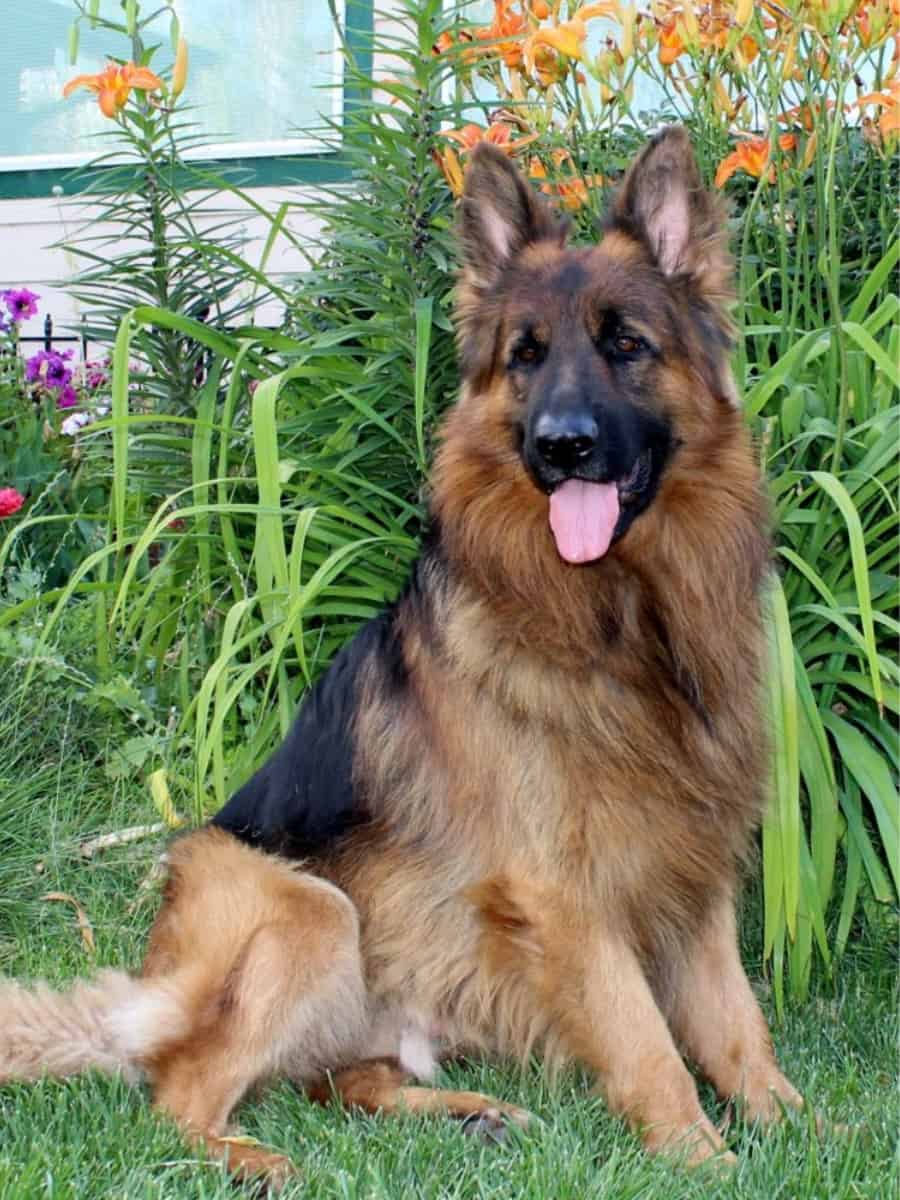
Are King Shepherds Recognized by the AKC?
It takes any new breed to be cemented past visual identifiers and have some genetic exclusivity before the American Kennel Club recognizes it. Most young breeds, and we’re talking about ones made in the 90s, are not recognized by the American Kennel Club, especially umbrella breeds. You can already guess the odds of AKC recognizing King Shepherds.
The AKC does not recognize King Shepherds for the same reason Pitbulls aren’t recognized: they aren’t an exact breed but are lumped as a breed based on certain similarities. Lack of recognition results in fewer information resources and literature regarding the breed, but this is changing.
With the American Kennel Club being no closer to recognizing the breed, there’s much more information on King Shepherds with more dedicated resources. More sources are willing to treat King Shepherds as a distinct breed.
But why? Because of money.
So, how do money and passion converge in making King Shepherds better recognized today?
The desire to get “bigger German Shepherds” comes with purchasing power. To market “bigger GSDs” without specifying the size or confusing consumers, a handy title like “King Shepherd” helps.
Suddenly, breeding businesses are more open to the idea of using “King Shepherd” as a breed title as opposed to “Cross-bred Giant German Shepherd,” as the latter isn’t marketing-friendly.
Learn More About King Shepherds In Our Video…
King Shepherd Appearance
A King Shepherd looks like a larger German Shepherd because it is bred specifically to be large while retaining the appearance of GSDs. The other significant difference is in the dog’s dense coat, which depending on the non-GSD parent and can be straight and coarse or long and less straight.
Regardless of the coat variety, a King Shepherd will have a thicker coat than a GSD because the coat type isn’t dictated as much by the German Shepherd genes.
The genes that dictate the look are more dominant among GSDs than the Great Pyrenees and Alaskan Malamute, while the ones that determine the dog’s size (and coat type) are dominant among the latter two.
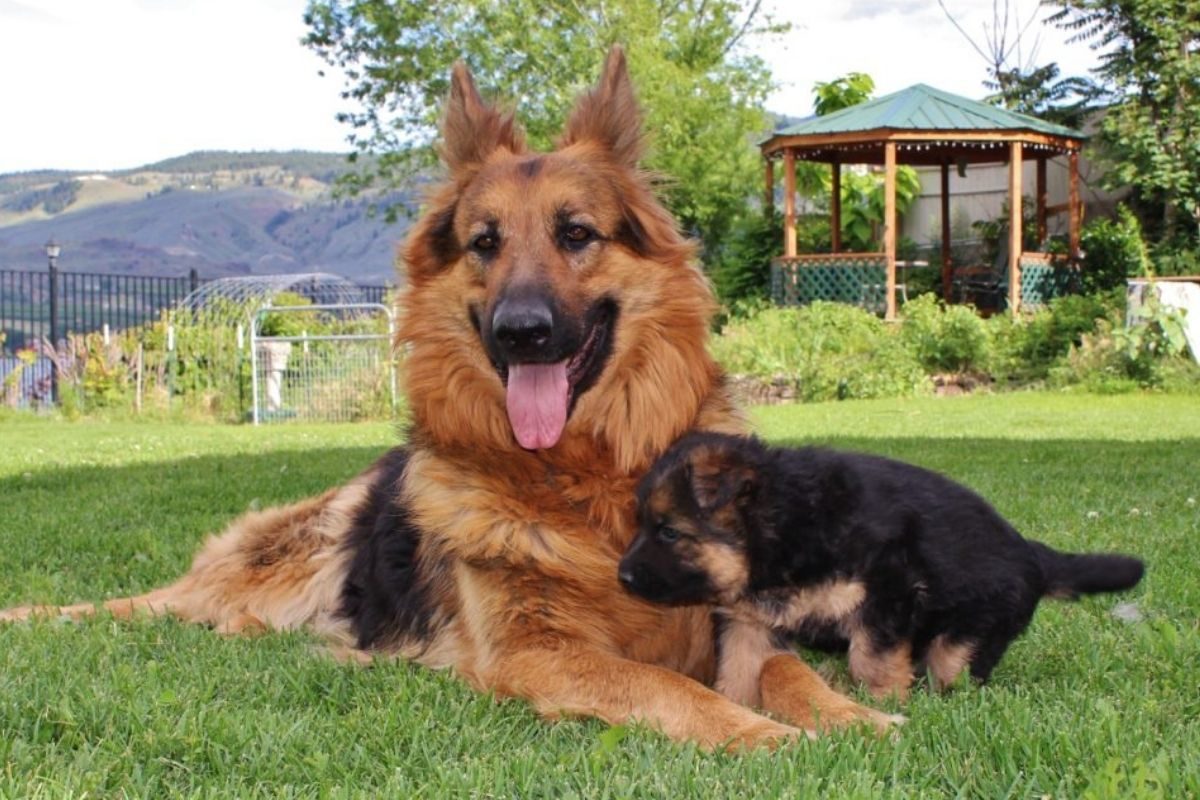
Coat colors will be black and tan, black and red, black, sable, or bi-color. Pale, washed-out colors are deemed as faults. Blue, white, or liver-colored dogs or a dog with a nose that is not black are disqualified.
How Big Do King Shepherds Get?
Knowing the maximum height of a breed is crucial because it allows you to decide if your home and yard have enough room and allows you to pick the right crate. You don’t even need to worry about the King Shepherd’s maximum height if you’re in an apartment because they are definitely not condos or apartment dogs.
King Shepherds can be up to 31 inches tall with a minimum height of 25 inches. The breed females are between 25 and 27 inches, while the males are 27 to 31 inches. In terms of weight, the females will weigh 90 to 110 lbs, with the males weighing between 130 to 150 lbs.
Their size makes them great guard dogs, as their presence is quite intimidating. Seeing a King Shepherd is enough to discourage intruders because if people don’t want to test a German Shepherd’s protective instincts, they surely don’t want to try their luck with what looks like a German Shepherd on steroids!
If the appearance isn’t enough, the loudness of GSD’s bark adds to their intimidating presence. The question, however, is whether these dogs are as aggressive as they are huge.
Temperament
King Shepherds are good family dogs as they are gentle and affectionate yet strong and protective. With proper socializing, they can be very personable, and their intimidating presence, alongside their kind nature, makes them perfectly pragmatic family dogs that are good with kids and other pets.
You don’t have to worry about aggression issues or sudden outbursts of unsocial behavior. At the same time, you can rest assured that intruders won’t take these dogs lightly as they would any other famously gentle breed. And that’s for one good reason: King Shepherds aren’t publicized enough for people to know what their nature is.
“As a result, people have only their personal connotations when assuming what a King Shepherd is like.”
Since the correlation between “big” and “aggressive” is well-cemented (yet ill-informed) in most people, they will assume that your King Shepherd is a warrior at heart, not knowing that the dog is called a “mild giant” among the insiders.
But gentle giants shouldn’t be confused with passive giants.
A passive dog will watch you get attacked as if he were witnessing a True Crime documentary on Netflix. A gentle giant with a protective instinct will jump into action and do what’s required to protect the people he cares about.
If you’re getting a King Shepherd as a family dog, it helps to know whether the dog is passive – or gentle yet protective.
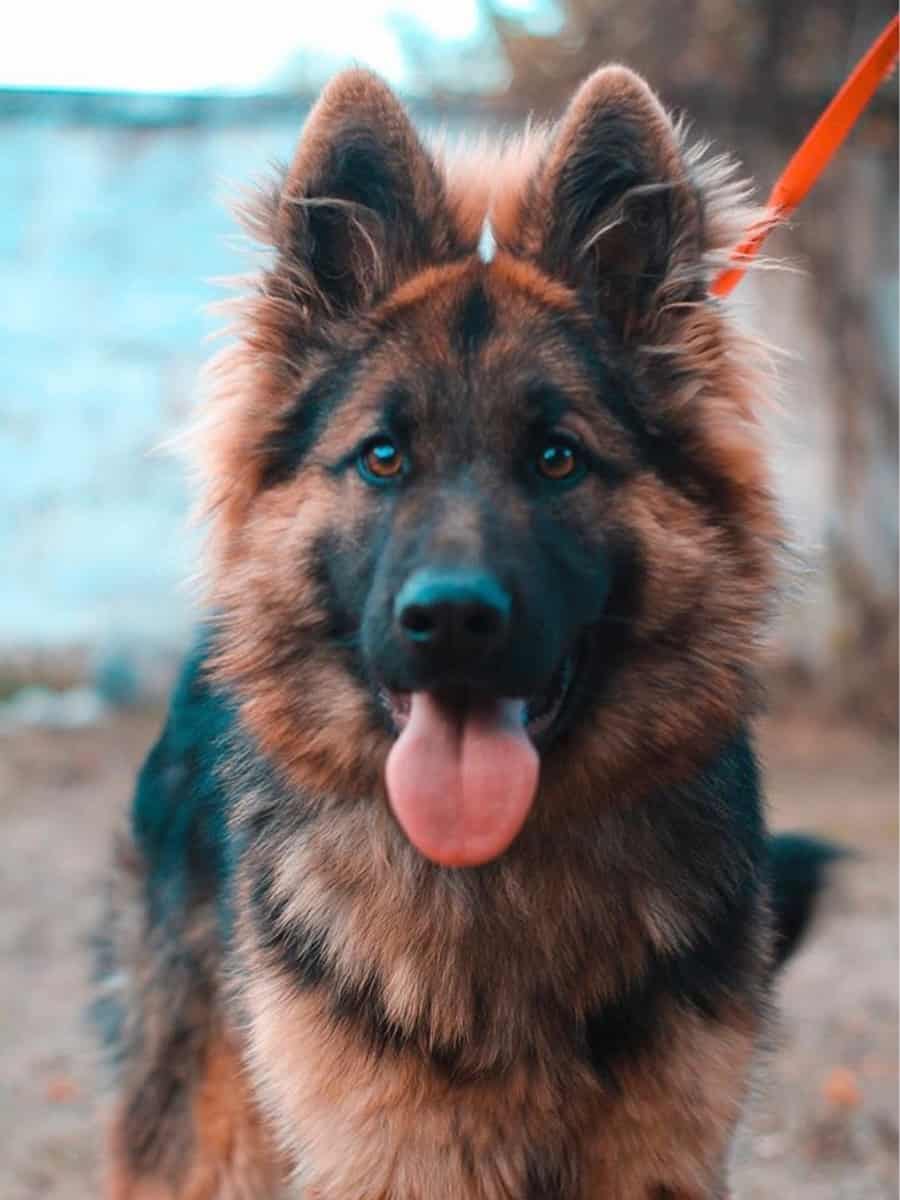
Are King Shepherds Protective?
Protectiveness can often come with social awkwardness or even straight-up unsocial behavior with dogs. Fortunately, that’s not the case with King Shepherds as long as you train them well.
King Shepherds are quite intuitive and intelligent and can be trained to be social. As a result, they can often distinguish between danger and strangers, something many loud dogs can’t do.
King Shepherds are protective of their owner and their family. In fact, a King Shepherd’s ability to be loyal to the whole family and snap out of his gentle nature to protect in key moments makes the dog ideal for families. These dogs were selectively bred to be loyal, protective companions.
Upon encountering a stranger who means no harm, a beagle or a terrier might start barking loud enough to put alarm manufacturers out of business. On the other hand, A King Shepherd will likely not feel threatened by one of your new friends saying hi.
A well-trained King Shepherd will observe the stranger’s demeanor and even your reaction to them before deciding whether he must let go of his playful nature and get into protection mode.
This brings up the otherwise touchy subject of training, which leads us to whether a first-time owner is equipped to deal with a King Shepherd.
Are King Shepherds Good for First-Time Owners?
King Shepherds are not good for first-time owners because they require a lot of patience, exercise, nuanced training, and care. Having experience with a low-maintenance dog like a dachshund or bullmastiff can help, though many have successfully raised King Shepherds without prior experience.
Ultimately, it comes down to whether you can fulfill what the dog requires so you can raise the dog you want.
As long as you can play the role of a King Shepherd’s human parent properly, there’s no license with prior experience required to own one. Here’s what you need to be willing to do.
- Have a lot of patience – Just like raising a German Shepherd, you need to have a lot of patience with a King Shepherd. However, with King Shepherd, you’re dealing with an even larger dog, which can be an even larger source of frustration.
- Have a lot of energy – If you come home exhausted, then you won’t have the energy to match your King Shepherd. These dogs have the enthusiasm of a German Shepherd multiplied by the size of the, well, King Shepherd! Be prepared for active days.
- Do a lot of brushing and de-shedding – If you can go a day without combing your hair, a King Shepherd isn’t for you because you’ll need to brush away the dog’s fur every day. These dogs shed a lot and require the excess hair to be continuously brushed off. They are also seasonal shedders and will molt even more during the Spring and Fall when they “blow their coat.”
Are King Shepherds Easy To Train?
King Shepherds are easy to train due to their high intelligence and immense desire to please their owner. Using positive reinforcement, they quickly learn to take instructions with little effort on the owner’s part. Nonetheless, training and socialization should start from a young age.
If you get a King Shepherd, make sure to adopt one at eight weeks old, so you can establish yourself as the guardian and can oversee proper command-reward perception.
Your King Shepherd will be easy to train as long as you can get your dog to learn the following lessons within the first two months of adopting him:
- When I listen to my owner, he is pleased, and I am rewarded.
- Other humans are friends too.
The first is obvious, but the second lesson is easy to miss. Some owners might even hesitate to train their dogs to be friendly with people, thinking they might lose their protective instincts. Even the friendliest King Shepherds will hop into action if they see their owner in danger.
Your King Shepherd’s friendliness to others doesn’t come at the cost of his loyalty to you. The two aren’t mutually exclusive, and the ability to sniff out danger is baked into canine DNA. The levels of protectiveness vary from breed to breed, as does the energy expended by each type of dog.
Exercise Requirements
A King Shepherd needs 1-2 hours of medium-intensity exercise daily as an adult and 20 to 30 minutes of low-intensity exercise as a puppy. They have lots of energy, thrive on mental and physical stimulation, need plenty of space to run around, and need access to various toys.
In other words, your dog must get the exercise he’s willing to engage in.
Let him exhaust himself and call it a day when you see he’s had enough. That said, you must be mindful not to let the dog exhaust himself too much, especially as a puppy, because King Shepherd puppies often don’t know their limit.
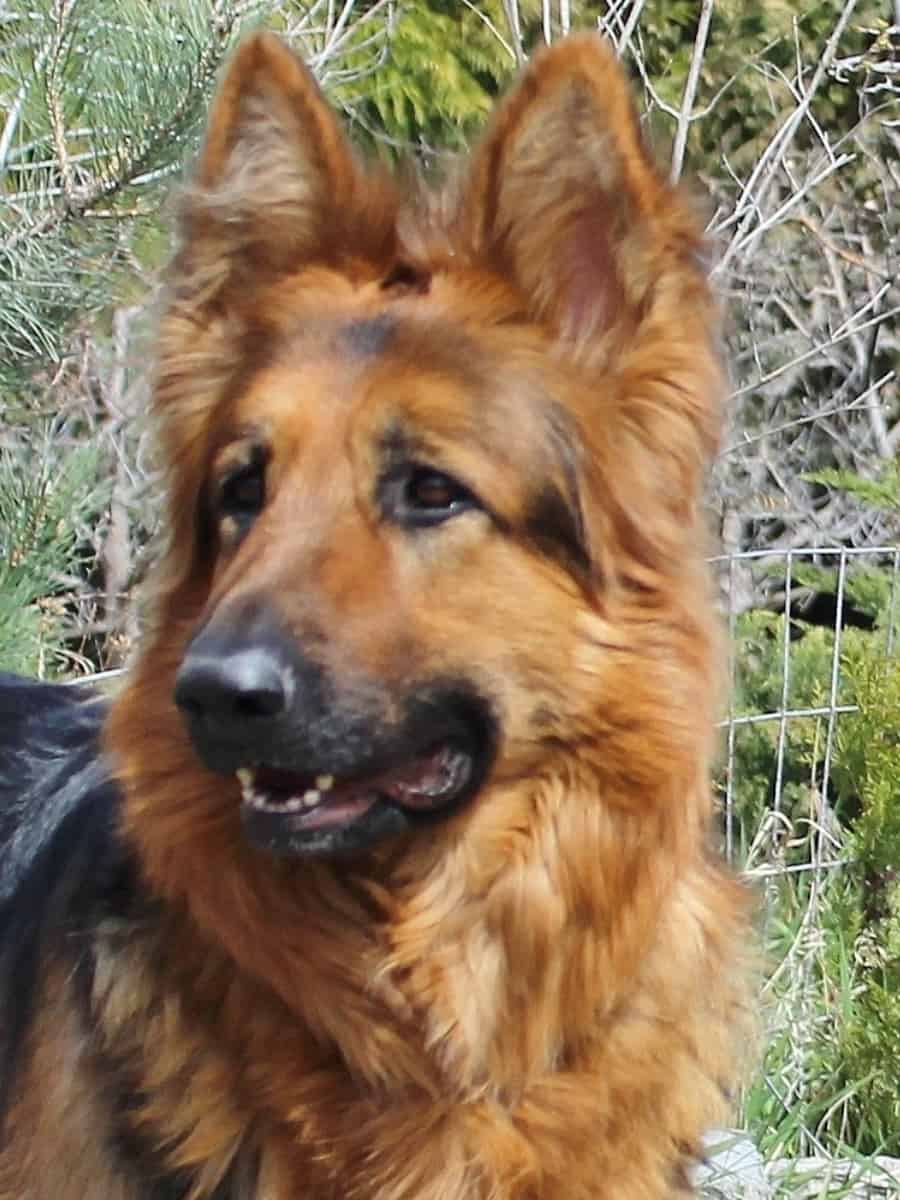
Do King Shepherds Shed?
King Shepherds shed due to their dense double coats, whether the long or medium-coated variety. They shed daily all year long and undergo seasonal shedding in the Spring and Fall when they change their soft undercoat. By brushing regularly, you can decrease the mess made by rogue fur.
Brushing your dog once a day allows you to get excess fur out of the fur forest that is a King Shepherd’s coat. You can minimize the mess made by King Shepherd shedding by vacuuming regularly and using a de-shedding tool.
Some people adjust their dog’s diet to reduce shedding, but there’s no scientific evidence to back the utility of such practices. King Shepherds need to shed, and it is healthy for their coat. Still, a healthy diet is helpful in other areas of the dog’s life.
King Shepherd Nutrition
The best diet for King Shepherds is a high-quality, protein-rich diet consisting of 18-22% protein. They are best suited to dry dog food, but you can add a topping for variety. They need to have the right mix of protein, fats, essential vitamins, minerals, and fiber for optimum health.
Choose a diet featuring grain carbs, animal byproducts, and added supplements. Look for Vitamin C, E, and B12 when considering different dog food products.
How Much Should a King Shepherd Eat?
A King Shepherd should eat three to four cups of large breed dry dog food as an adult. Seniors have a lower appetite and calorie requirement but might do well with three cups of food with a similar calorie count or four cups of dog food designated for large breed dogs of advanced age.
This should be divided into two to three meals a day, depending on the size and age of the dog. At a minimum, you must be prepared to feed your King Shepherd twice daily. Large meals are not advised to prevent bloating.
Health Issues
King Shepherds have fewer health problems than German Shepherds but are still prone to certain diseases, including Hypothyroidism, Joint Dysplasia, Von Willebrand’s disease, and Degenerative Myelopathy. In some cases, they can also suffer from bloat (GDV) and seasonal allergies.
The above list is not intended to persuade you into buying a German Shepherd instead because one of the key reasons King Shepherds were created was to avoid the problems that came with intra-breed reproduction (breeding within the breed).
By breeding German Shepherds with other breeds, the chances of recessive disease-causing traits becoming prominent in the offspring are reduced.
But fewer diseases don’t necessarily mean a longer life.
Lifespan
The lifespan of a King Shepherd is around ten to eleven years, which is around two years shorter than its German Shepherd ancestors. This difference is a key contributor to the persistent relative popularity of German Shepherds over King Shepherds.
That said, German Shepherds don’t always live to their maximum lifespan either. That’s why instead of fixating on lifespans, we must focus on giving our pets the best company and ensuring they are properly cared for.
King Shepherd Price
King Shepherds cost, on average, $1500. However, some can cost up to $3,000. The more expensive varieties feature stronger lineage and better health expectancy and longevity. Prices are also affected by the breeder’s reputation, location, litter size, health screening, and vet fees.
King Shepherds also require a large living space, so high-income households often adopt them. The target market’s disposable income plays a huge role in maintaining the high price.
If King Shepherd buyers were bargain hunters, breeders would compete to lower prices and generate revenue. Such competition, however, isn’t incentivized in the niche market of King Shepherds as budget sellers are seen with a suspicious eye.
Where Can I Buy a King Shepherd?
You can buy a King Shepherd from a reputable and ethical breeder. However, due to the breed’s rarity, you may have better luck with breeders who offer GSD puppies and Great Pyrenees or Alaskan Malamute pups because they have the mating dogs required to create a King Shepherd litter.
Please remember to get complete information on each of the parents and any expected health complications that the King Shepherd may have inherited.
You must insist on getting these details as the availability and disclosure of this information acts as a sign of professionalism and indicates that the breeder is reliable.
Unscrupulous breeders might have cruel breeding practices or may pass on a defective dog just to get the high price tag associated with this rare breed.
FAQs
Are King Shepherds good with kids?
King Shepherds are good with kids and get along with the ones they have been raised with. They are patient, gentle, and playful, and they will not threaten strangers’ children if socialized properly. They are also good with other pets in the same household, making them great family dogs.
What are the most common health problems for King Shepherds?
The most common health problems for King Shepherds are hip and elbow dysplasia, progressive retinal atrophy (PRA), and bloat. Hip and elbow dysplasia are inherited joint disorders that can cause pain and lameness in the affected dog. This condition is caused by malformation of the hip or elbow joint, which can lead to a decrease in mobility and an increase in pain.
Are King Shepherds good guard dogs?
King Shepherds are good guard dogs as they protect their family. As their parent breeds were either herding, protection, or other working dogs, it’s in their genes for these dogs to naturally want to protect. They are also, by nature, big enough to intimidate and keep intruders at bay.
Are King Shepherds used as Police dogs?
King Shepherds are not used as police dogs because they lack the killer instinct to remain sharp on duty. Although protective, they are also playful and gentle, and their size advantage helps only guard idle property, not on mobile duty. Their shorter lifespan is also a disadvantage.
Are King Shepherds hypoallergenic?
King Shepherds are not hypoallergenic as they are heavy shedders, have thick coats, and often muddy paws. This means the shed fur can cause an allergic reaction, their thick coats can carry allergens like pollen, and their paws can be dirty, which might also trigger a reaction.
Is a King Shepherd Right For You?
A King Shepherd is right for you if you have a big home, are an energetic person, and have plenty of time for training and socialization. If that sounds like you, then you’ll enjoy the following pros:
Pros:
- Playful nature, fun, and active lifestyle
- Intimidating presence, no one messes with you
- Protective instincts and loyalty to your whole family
- Fewer health issues, less suffering in later years
However, these advantages come with the following drawbacks:
Cons:
- Big shedders, you spend a lot of time vacuuming
- Require daily grooming
- Short lifespan
Related Posts You May Like:





